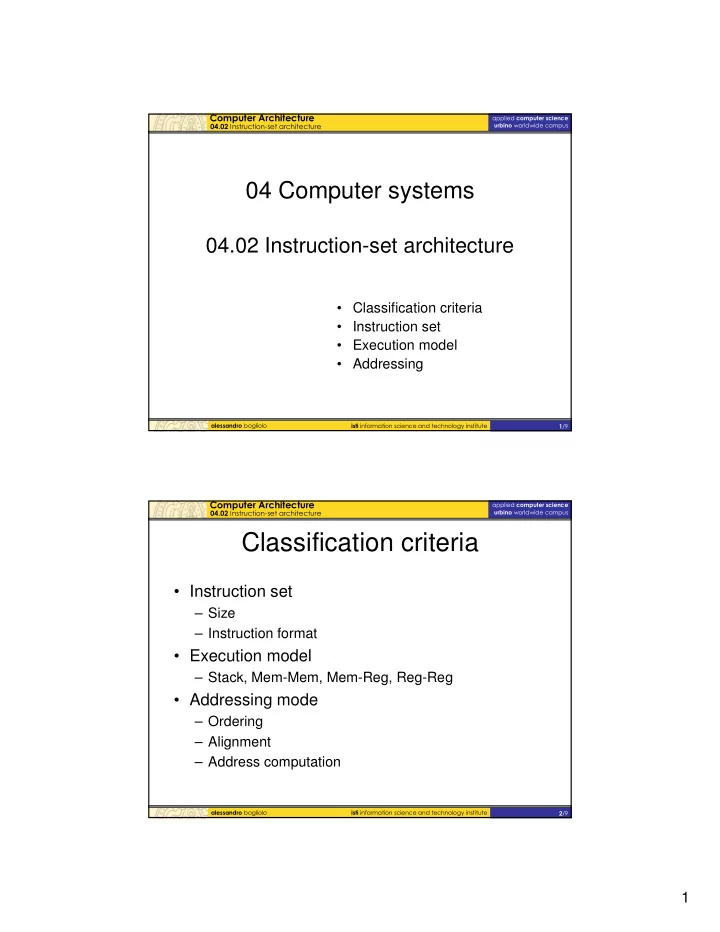

��������������������� �������� ���������������� ������ ���������������������������� ������ ���������������� 04 Computer systems 04.02 Instruction-set architecture • Classification criteria • Instruction set • Execution model • Addressing ���������� �������� ���� �������������������������������������������� � �� ��������������������� �������� ���������������� ������ ���������������������������� ������ ���������������� Classification criteria • Instruction set – Size – Instruction format • Execution model – Stack, Mem-Mem, Mem-Reg, Reg-Reg • Addressing mode – Ordering – Alignment – Address computation ���������� �������� ���� �������������������������������������������� � �� 1
��������������������� �������� ���������������� ������ ���������������������������� ������ ���������������� Instruction-Set • RISC – All instructions have the same size – The OpCode has a fixed position and size within the instruction – There are only a few different formats – There is a single format per OpCode • CISC – Different instructions may have different size – The OpCode has variable position and size – There are many different formats ���������� �������� ���� �������������������������������������������� � �� ��������������������� �������� ���������������� ������ ���������������������������� ������ ���������������� Execution model (1) • STACK – A stack is a first-in-last-out queue – Internal registers are handled has a stack – Operands are always taken from the top of the stack – Results are always put at the top of the stack – Source and destination registers do not need to be specified ���������� �������� ���� �������������������������������������������� � �� 2
��������������������� �������� ���������������� ������ ���������������������������� ������ ���������������� Execution model (2) • MEM-MEM – A single instruction takes the operands from memory, computes the result and puts it back in memory – No internal (general-purpose) registers are required • MEM-REG – At most one operand can be taken directly from memory – At least 1 general-purpose register is required • REG-REG – Both operands and results are internal registers ���������� �������� ���� �������������������������������������������� � �� ��������������������� �������� ���������������� ������ ���������������������������� ������ ���������������� Execution models comparison Example • Example: A � B+C Where A, B and C are memory elements (i.e., variables) MEM-MEM MEM-REG MEM-REG-1 REG-REG STACK ADD A,B,C LOAD R1,B LOAD B LOAD R1,B PUSH B ADD R3,R1,C ADD C LOAD R2,C PUSH C STORE A,R3 STORE A ADD R3,R1,R2 ADD STORE A,R3 POP A A <-- B+C R1 <-- B R1 <-- B R1 <-- B R3 <-- R1+C R1 <-- R1+C R2 <-- C A <-- R3 A <-- R1 R3 <-- B+C A <-- R3 PUSH B PUSH C ADD POP A C B B B+C ���������� �������� ���� �������������������������������������������� � �� 3
��������������������� �������� ���������������� ������ ���������������������������� ������ ���������������� Addressing Byte ordering • Memory addresses are assigned with bytes • Handling single bits requires Boolean masks • Words of 2, 4, 8 bytes can be handled as a whole (i.e., by a single instruction) – In this case a single address is specified for the entire word and a criterion is required to retrieve all the bytes – Little Endian : the word address is the address of the least significant byte of the word – Big Endian : the word address is the address of the most significant byte of the word ���������� �������� ���� �������������������������������������������� � �� ��������������������� �������� ���������������� ������ ���������������������������� ������ ���������������� Addressing Alignment • 32-bit memories make 4 bytes addressable as a whole as long as the address is divisible by 4 (i.e., the word is aligned with the memory) • Misaligned words require 2 bus cycles to be completely read/written Big Endian Little Endian 3 2 1 0 i i 0 1 2 3 3 2 1 0 i+4 i+4 0 1 2 3 3 2 1 0 i+8 i+8 0 1 2 3 3 2 1 0 i+12 i+12 0 1 2 3 D31-24 D23-16 D15-8 D7-0 D31-24 D23-16 D15-8 D7-0 ���������� �������� ���� �������������������������������������������� � �� 4
��������������������� �������� ���������������� ������ ���������������������������� ������ ���������������� Addressing Address computation Direct R1 � M[var] LD R1,var var Indirect (R2) R1 � M[R2] LD R1,(R2) (R2) Relative to registers var R1 � M[R2+var] LD R1,var(R2) (R2) var Relative to registers, indexed and scaled (RX)*d LD R1,var(R2)(RX) d R1 � M[R2+var+RX*d] ���������� �������� ���� �������������������������������������������� � �� 5
Recommend
More recommend